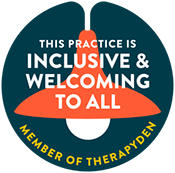Oftentimes, this big shift in hormones leads to feelings of sadness and tearfulness, feeling restless or anxious, and not feeling like yourself. Additionally, people who are in the postpartum period worry that they’re not being a good parent or that their sadness is going to be indicative of how their parenting journey continues.
The key distinguisher between Baby Blues and Postpartum Depression is the timeline. The Baby Blues period ends around the two week mark postpartum.
Diagnosis #2. Postpartum Depression
Postpartum Depression (PPD), also called postnatal depression, occurs after the two-week period Baby Blues. PPD is an acute form of Major Depressive Disorder. However, some people who have given birth, may already have been given a diagnosis of Major Depressive Disorder before or during pregnancy, but can experience an increase in severity and frequency of their depressive symptoms during this time. The onset of PPD occurs within the first 4-6 weeks of the postpartum period and typically lasts an average of 6 months but can last for as long as 12 months.
The symptoms of a depressive episode include:
- Depressed mood for most of the day, nearly everyday, diminished interest or pleasure in doing this
- Significant changes in weight (can be hard to assess for during postpartum due to hormonal changes
- Breastfeeding or pumping, and body changes due to having a baby) or appetite
- Significant changes in sleep patterns (however this can be difficult to assess for during postpartum due to the changes in sleep patterns needed for caring for an infant)
- Changes in pace of movement whether moving slower talking slower than usual or being restless and agitated or fatigued (can be difficult to assess during postpartum due to fatigue being a natural reaction to sleep deprivation)
- Feelings of worthlessness or excessive guilt
- Difficulty concentrating (again, sometimes hard to assess due to sleep deprivation)
- Recurrent thoughts of death or suicidal ideation
As stated above, sometimes it can be hard to differentiate between symptoms of depression and natural reactions to a huge shift in lifestyle in the postpartum period.
However, PPD can also look a bit different than a typical depressive episode. Understandably, many new parents experience a big increase in anxiety. PPD and postpartum anxiety are often used interchangeably, even though outside of the postpartum period, Major Depressive Disorder and Generalized Anxiety Disorder are not used interchangeably.
Generally, there are normative ranges for anxiety in the postpartum period. Anxiety is an emotion that we need as humans in order to stay safe and get things done. However, when anxiety is more intense and frequent than is useful, that is when we consider it part of a disorder.
Yes, it’s normal to worry about how a newborn baby is doing—to an extent.
But if you find yourself…
- Feeling on edge constantly
- Needing to check the baby’s vitals nonstop, even though they are medically sound
- Googling for hours a night about what is normal (again, to the point of functional impact like not sleeping in the few hours you are able to, or not being able to focus on your time spent with your baby at all because you are so worried about a perceived abnormality)
…then you may be experiencing postpartum depression/anxiety.
People who live in urban areas, with low incomes, and people with other mental health diagnoses are at higher risk for PPD. Additionally, people who have a perceived or actual lack of social support, stressful life events occurring, relationship issues, difficult pregnancy and labor and delivery, childcare stress during the postnatal period are at higher risk for PPD.
A parent who did not give birth to a child can also experience PPD. While these parents do not have a hormonal shift, PPD can still occur and should be treated and not dismissed.
The use of this diagnosis is not to invalidate the real difficulties that occur during the postpartum period. It’s natural to have some mood changes during a huge life altering shift and it is natural to worry about your newborn and your relationship with your newborn during this time period. However, it is important to recognize when sadness and anxiety move beyond the norm and into the PPD range because taking care of your emotional wellbeing will help you take care of your child and help you feel like yourself, which benefits you and your baby.
Fortunately, there are many treatments, both pharmacological and nonpharmacological for PPD and seeking out help is the best choice you can make. Having PPD is not a failing on the parent’s part, but rather, it is a combination of hormonal changes, environmental factors, genetic predisposition and more.
Diagnosis #3: Postpartum Obsessive Compulsive Disorder
Postpartum OCD (pOCD) is similar to typical OCD but begins in the postpartum period. Postpartum OCD can be particularly distressing due to the nature of intrusive thoughts associated with OCD. There are different subtypes of intrusive thoughts including harm OCD, sexual orientation OCD, Pedophilia OCD, Relationship OCD, Just Right OCD, Religous OCD and more. Any subtype can occur during pOCD. It is important to note that there are often obsessive thoughts, such as feeling your child is always in danger, and compulsions, such as seeking reassurance that you are a good parent or avoiding being alone with your child, during the postnatal period.
Other subtypes of OCD can happen as well during the postnatal period including Pedophilia OCD and Harm OCD. It is important to remember that these subtypes of OCD do not indicate that you will harm your child or other children. Postpartum OCD is not associated with committing violence. It can be scary to discuss these thoughts with your trusted people or a clinician but the first step to getting help is letting someone know what is going on. You may worry that people will think you are a danger or unfit to parent, but having pOCD does not make you an unfit parent or that you are going to harm your child. It can cause functional impairments and change your parenting behaviors, so if you are scared to be alone with your child or do not trust yourself, it is important to seek out professional help which includes therapy and possible pharmacological treatment.
4. Postpartum Psychosis
Postpartum Psychosis is very rare (affecting .01% of parents who gave birth), however it can happen. Postpartum Psychosis can be confused with pOCD because there may be similar thoughts about harm to the child. However, the major difference is that Postpartum Psychosis includes hallucinations and delusions, which means that the person experiencing Postpartum Psychosis is unable to tell reality from not. Postpartum psychosis is often associated with already existing Bipolar I disorder or mood episodes featuring psychotic features. Hallucinations and delusions mean there is a break from reality because the parent is seeing or hearing things that are not really there or having strong beliefs that are not based in reality. Examples include: “The baby is possessed by the devil and I must kill him to save his soul;” or seeing the child turn into the devil. Not all hallucinations or delusions are destructive. They could be completely unrelated to harming the child or themselves. There is a risk to both the child and parent in this situation so immediate intervention with professional help is necessary. It is important to note that the vast majority of people experiencing postpartum psychosis will not hurt themselves or the child.
It can be scary to see your loved one experiencing these symptoms and it is important to seek professional help immediately. Postpartum psychosis is temporary and will get better with professional treatment.
5. Post-traumatic Stress Disorder (PTSD)
PTSD can occur from labor and delivery. There are many things that could go wrong during labor and delivery which qualify as traumatic events. At least 1 in 3 women report the presence of at least three acute trauma symptoms after delivery (book). This trauma could be injury or harm to the birthing parent, the child, perceived danger to the birthing parent or child, mistreatment or abuse from medical providers, and more. Additionally, it can be traumatic to have your child admitted to the NICU for treatment post birth. PTSD from labor and delivery is associated with re-experiencing symptoms and avoiding situations that can impact the person’s ability to care for the child and themselves. Please see my previous blog post to learn more about trauma and PTSD at https://orchardmentalhealth.com/expanding-what-we-think-of-as-trauma/.
6. Dysphoric Milk Ejection Reflex (D-MER)
D-MER is a strong feeling of depression and dysphoria seconds before the let down reflex during breastfeeding. It differs from PPD because these negative feelings and thoughts only occur in the let down period of breastfeeding. D-MER is rare but very impactful when it occurs. It can be experienced as hollow feelings in the stomach, anxiety, sadness, dread, introspectiveness, nervousness, emotional upset, angst, irritability, and hopelessness. This happens due to a dysfunctional hormone shift and can cause severe distress. For more information on D-MER please visit https://d-mer.org/.
The postpartum period is a sensitive time in parents’ lives and there is no shame in needing help during this huge life shift. Please reach out to QOP to set up an appointment with a therapist to help during this time or talk to your OBGYN about available resources.
References:
A., V. den A., Olga B. (2012). Reproductive Health Psychology. John Wiley & Sons.
Post partum psychosis Postpartum Support International
https://d-mer.org/
ICOD Postpartum OCD Fact Sheet
Baby Blues March of Dimes
Breast Feeding ASN D-MER.























